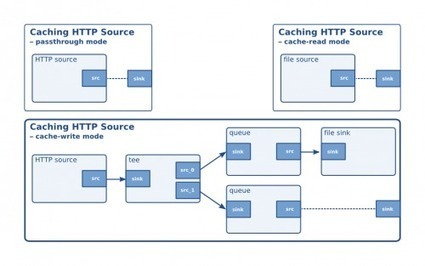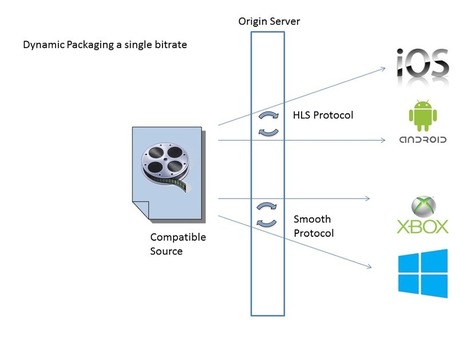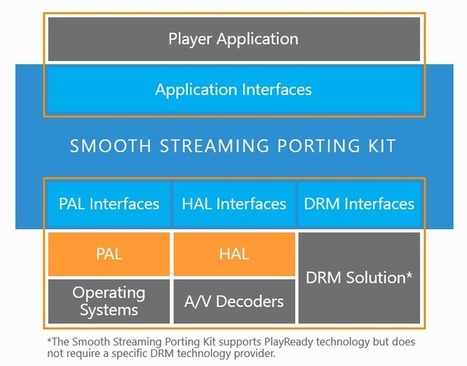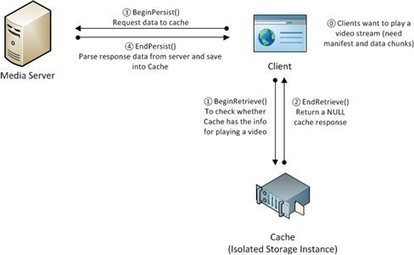 Your new post is loading...
 Your new post is loading...
Let’s talk a bit about HTTP Adaptive streaming and GStreamer, what it is and how it works. Especially the implementation in GStreamer is not exactly trivial and can be a bit confusing at first sight.
If you’re just interested in knowing if GStreamer supports any HTTP adaptive streaming protocols and which you can stop after this paragraph: yes, and there are currently elements for handling HLS, MPEG DASH and Microsoft SmoothStreaming.
With the rise of MPEG-DASH and the NAB-related announcements from both Microsoft and Adobe on the topic, we sat down with both companies to discuss the status of DASH support as well as their legacy ABR protocols, Smooth Streaming and HDS. In late 2012, Microsoft release the specification “DASH Content Protection using Microsoft PlayReady,” which explained how to use PlayReady with Common Encryption and MPEG-DASH. In June 2013, Windows Azure Media Servicesadded the support for MPEG-DASH as a new Dynamic Packaging output. At IBC 2013, Microsoft officially announced a new PlayReady version supporting HTML5, Encrypted Media Extensions, as well as new SDKs for iOS and Android. Their recent NAB 2014 announcements show how much work has been done under the hood to support DASH on the maximum number of platforms. We put a few questions to the Windows Azure Media Services team—namely senior digital media architect Kilroy Hughes, principal program manager lead John Deutscher, program manager for dynamic packaging Nick Drouin and program manager for client SDKs Cenk Dingiloglu. Here’s what they told us.
Via DASH Industry Forum
Smooth Streaming and MPEG-DASH Client 2.5 SDK enables you to build rich IIS Smooth Streaming experiences for both on-demand and live IIS Smooth Streaming for Silverlight and Windows Phone 8 applications. In addition, MPEG Dynamic Adaptive Streaming over HTTP (DASH) for Silverlight on-demand scenarios using the Live Profile support has been added to the 2.5 release.
MPEG DASH is now a supported feature, so developers that wish to move content libraries to DASH have the option of using DASH in places where Silverlight is supported. The existing SSME object model forms the basis of DASH support in the SSME. DASH concepts like Adaptation Sets and Representations have been mapped to their logical counterpart in the SSME. Adaptation Sets are exposed as Smooth Streams and Representations are exposed as Smooth Tracks. Existing Track selection and restriction APIs can be expected to function identically for Smooth and DASH content. In most other respects, DASH support is transparent to the user and a programmer who has worked with the SSME APIs can expect the same developer experience when working with DASH content.
Bridge Technologies has launched PocketProbe, an iPhone app that enables objective analysis of real network performance of streaming media, in a simple to use, easy to understand tool that technical staff can carry anywhere. PocketProbe contains the same OTT Engine found in the company’s VB1, VB2 and 10G VB3 series digital media monitoring probes, enabling confidence validation and analysis of http variable bit-rate streams from any location.
PocketProbe is available in two versions: the free application can validate five HLS streams in round-robin mode, provide analysis and manifest consistency alarms, play back media in the various profile bit-rates, and graphically display the actual chunk download patterns and bit-rates. The full version also offers the ability to validate HDS and SmoothStream manifest files and store twenty-five streams with all profiles.
Agama Technologies, the video service quality assurance expert, is introducing the next generation of its Analyzer OTT for adaptive bitrate (ABR) streaming services at TV Connect 2013. The Analyzer OTT supports continuous 24/7 monitoring as well as testing and troubleshooting applications, making it ideal in all phases of deployment, operation and expansion. Both Microsoft Smooth Streaming services and Apple HTTP Live Streaming services can be analyzed in any combination. Sophisticated multi-dimensional presentation of QoE and QoS with timeline analytics provide a solid understanding of relevant technical quality parameters and how they affect the viewing experience.
Does anyone have any information on the new ‘on the fly converting’ for media services?
Yes, that feature is shipping in the coming days, we refer to it as dynamic packaging, you could also call it just-in-time packaging, dynamic muxing, etc. Specifically, it will offer the ability to: Transmux from a single source format into two different streaming formats.
The actual OTT market uses Adaptive Bit Rate video format over HTTP (Smooth Streaming, HTTP Dynamic Streaming, HTTP Live Streaming and MPEG-DASH soon) to deliver the content. Although it excludes the DRMs system which is a big topic in itself, here is an overview of the different formats available for each platform and of the different solutions (self-hosted, CDN, Cloud) to handle it.
DVEO, the broadcast division of Computer Modules, Inc. (CMI), is now shipping their new continuous streamer and VOD (video-on-demand) media server. The Infinity Streamer™ streams multiple HLS video files, plus audio files, from the on board .5 TB drive, with scheduled playlists. DVEO will demonstrate the new system at the International Broadcasting Convention (IBC) in Amsterdam, September 7-11, at Stand 2.A54. The Infinity Streamer is a streaming server for stored content. Input can be individual files or multiple files. File types supported are H.264 ts, flv, H.264 ps, .mov, VC-1 (.wmv), mkv, and others. The Infinity Streamer also supports loopable playback. The system has been tested to be compatible with the latest Adobe®, Wowza®, and Real Helix™ servers, and many CDNs.
SPB TV Solution empowers 3D and regular 2D video formats encoding and streaming in multiple quality options, from mobile to HD, to provide the brightest user experience on a small phone as well as on a big modern TV. Due to anaglyph and side-by-side technology support, 3D video can be delivered to both 3D-enabled and usual screens. SPB TV pays great attention to the stability and quality of the video playback in any network capabilities, so its solutions support all major technologies of adaptive streaming: RTSP, Apple HTTP Live Streaming (HLS), Microsoft Smooth Streaming, Adobe HTTP Dynamic Streaming, as well as MPEG-DASH - a new unified adaptive bitrate standard developed by ISO.
Smooth Streaming has been a pivotal technology of the Microsoft Media Platform since its introduction in IIS Media Services 2.0 in 2009. And though it’s been commonly associated with Silverlight over the years, those familiar with Smooth Streaming architecture and the Smooth Streaming Media Element probably know that the relationship between Smooth Streaming and Silverlight was never an exclusive one. For starters, the Smooth Streaming Protocol Specification and the Protected Interoperable File Format (PIFF) Specification have been public for years. After all, at its heart Smooth Streaming is not much more than a combination of HTTP requests, XML and fMP4 parsing, download heuristics and video/audio decoding. It’s a fairly open, standards-based technology that has very few dependencies on the client platform.
At last November's Streaming Media West, the standing-room only crowd listened as the MPEG DASH Promoter's Group (DASH PG) espoused the yet-to-be-ratified International Standards Organization (ISO) standard for DASH (dynamic adaptive streaming over HTTP). Fast forward to April 2012, and the ratified ISO/IEC 23009 DASH train seems to be picking up steam, as companies from Microsoft to Wowza, Broadcast International to Fraunhofer Laboratories have pledged support. From a media server perspective, Microsoft's announcement of Windows Azure Media Services, which we covered yesterday, didn't first strike us as a DASH play, but a blog post on the Microsoft Media Platform team blog brings DASH front and center as part of the Azure strategy.
Digital Rapids announces powerful new enhancements to the Digital Rapids Stream software for the company's StreamZ, StreamZHD and Flux encoding solutions. The same new capabilities are also available as applicable in the StreamZ Live family of live streaming encoders and the Digital Rapids Transcode Manager automated, high-volume file transcoding software. Recently-released or soon-to-ship new features include enhanced Closed Caption support for adaptive bit rate streaming and support for automated advertising insertion when streaming live with Adobe Flash technologies. Recently released new software updates add support for Closed Captions with Microsoft IIS Smooth Streaming technology and with HTTP Live Streaming through the optional iPhone/iPad encoding module. Expanded support for the use of cueing messages with Adobe Flash technologies enhances content owners' ability to monetize their media across multiple screens in fully automated workflows. Cueing messages in live input sources, commonly used in broadcast operations, can be detected to automate the insertion of cue points into outputs targeting Adobe Flash Player and Adobe AIR applications. Additional new features in the latest software updates include DFXP timed text file creation from live and file-based sources.
The term adaptive streaming refers to technologies that encode multiple instances of a live or on-demand stream and switch adaptively among those streams to deliver the optimal experience to each viewer, taking into account both delivery bandwidth and playback horsepower. Producing for adaptive streaming involves two discrete analyses: how to choose the optimal number of streams and their configurations and how to customize the encoding parameters of the various streams to operate within each adaptive streaming technology. This article will explore both analyses.
|
The Hippo Media Server is a simple, standalone HTTP server designed to simplify the delivery of MPEG DASH and Smooth Streaming media. MPEG DASH and Smooth Streaming are both protocols for HTTP-based adaptive streaming. With adaptive Streaming, a media presentation is served to streaming clients as a sequence of small media segments (each segment containing typically 2 to 10 seconds of audio or video). Each segment is accessed over HTTP with an individual URL. In order to serve an adaptive streaming presentation with a regular HTTP server like Apache, Nginx or other populare HTTP servers, one needs to split the original media files into small individual files, one for each segment, so that they can be accessed through separate URLs. This can be very difficult to manage. The Hippo Media Server implements a simple URL virtualization scheme: instead of mapping each URL to a file in the server's filesystem, each URL consists of a pattern, which is parsed by the server when it handles a request, and from which it can locate the appropriate portion of a file in the filesystem. This way, a single media file containing the media data for the segments can be represented as discrete URLs.
Now Azure Media Services allow you to deliver Http-Live-Streaming (HLS) and Smooth Streams encrypted with Advanced Encryption Standard (AES) (using 128-bit encryption keys). Media Services also provides the key delivery service that delivers encryption keys to authorized users.
Azure Media Services also provides a Microsoft PlayReady license delivery service. PlayReady is a full-featured content access protection technology developed my Microsoft that uses Digital Rights Management (DRM). It protects a content media stream during playback by using a license server that provides the decryption key needed to decrypt the media stream. Firstly, you need to pre-encrypt Smooth Streaming file with PlayReady License, by providing us License Acquisition URL, Key ID and Content Key. You could follow this MSDN article to use Azure Media Encryptor to encrypt the Smooth Streaming file. As a output, you could further package the encrypted Smooth Streaming into HLS and DASH (See how here). You could also define how the license could be authorized to your user. Similar to AES dynamic encryption, we enable Token/IP/Open authentication service.
Which platform/devices that PlayReady SDK covers?Azure Media Services can be used to encode, download, or stream Smooth Streaming or MPEG DASH content encrypted with PlayReady. For consuming PlayReady encrypted content, client SDKsand the PlayReady Porting Kit are available under commercial licensing terms. (PlayReady clients for Windows 8.1 Store Apps can be built using the free SDK located HERE). These client-side SDKs are not part of this preview.
This blog gives an overview of what kind of client support Microsoft offers as part of Windows Azure media Services. On one side, you could create, manage, package and deliver media asset through Windows Azure media services. Many popular streaming formats are supported, such as Smooth Streaming, Http Llive Streaming and MPEG-dash. On the other hand, we provide various SDKs and frameworks for you to consume media asset by building rich media applications rapidly on many platforms, such as PC, XBox, mobile and etc.
Just in time for NAB, VisualOn and Discretix are announcing the release of SecurePlayer 2.0, which provides publishers with iOS and Android playback protected with Microsoft PlayReady DRM (digital rights management). The player works with MPEG-DASH, HLS, and Smooth Streaming content. SecurePlayer 2.0 combines VisualOn's OnStream MediaPlayer+ with Discretix's DRM security.
It's all about DASH: Adoption is moving at a rapid pace, as industry insiders see a strong need to get DASH implemented in the field in the coming year. The Pantos spec, as it is known in the industry, is a series of working drafts for HLS submitted by two Apple employees as an information draft for the Internet Engineering Task Force. As of the time of this article, the Pantos spec is currently at informational version 10. Much has changed between the early versions and the most recent v10 draft, but one constant remains: HLS is based on the MPEG-2 Transport Streams (M2TS), has been in use for almost 2 decades, and is deployed widely for varied broadcast and physical media delivery solutions. In that time frame, however, little has changed for basic M2TS transport stream capabilities. For instance, M2TS still lacks an integrated solution for digital rights management (DRM). As such, all HLS versions cannot use "plain vanilla" M2TS, and even the modified M2TS used by Apple lacks timed-text or closed-captioning features found in more recent fragmented elementary stream streaming formats. Yet Apple has been making strides in addressing the shortcomings of both M2TS and the early versions of HLS: In recent drafts, the HLS informational draft allows for the use of elementary streams, which are segmented at the time of demand rather than beforehand. This use of elementary streams means that one Achilles' heel of HLS -- the need to store thousands, tens of thousands, or hundreds of thousands of small segments of long-form streaming content -- is now eliminated. Google, with its Android mobile operating system platform, has adopted HLS for Android OS 4. Some enterprising companies have even gone back and created HLS playback for earlier versions of Android OS-based devices.
Click here to edit the content...
The Smooth Streaming Client SDK for Windows 8 enables playback of Smooth Streaming content in conjunction with the Windows 8 HTML5< video> element and XAML MediaElement by using the default APIs such as Play and Pause. Besides basic playback, the Smooth Streaming SDK has rich features like the ability to restrict the quality levels, do Live DVR, switch audio streams, and listen for status updates (such as quality level changes) and error events, and so on.
In this post, I'll cover how to enable these rich features of Smooth Streaming SDK for Windows 8. For rich applications powered by these features and general player development, I strongly encourage you to use the Microsoft Media Platform Player Framework. You can get more information about the Player Framework here.
Over the last few weeks, Windows Azure Media Services was used to deliver live and on-demand video streaming for multiple Olympics broadcasters including: France Télévisions, RTVE (Spain), CTV (Canada) and Terra (Central and South America). Partnering with deltatre, Southworks, gskinner and Akamai - we helped to deliver 2,300 hours of live and VOD HD content to over 20 countries for the 2012 London Olympic games. Below are some details about how these broadcasters used Windows Azure Media Services to deliver an amazing media streaming experience...
An FFmpeg-based live and offline encoder that outputs HLS archives or publishes to IIS Live Smooth Streaming endpoints. Can capture video from DirectShow cameras and audio equipment. Can use a plugin framework for audio and video pre-processing (includes a tone-detector and a watermark plugin). Uses the FFmpegControl library for encoding and decoding.
Taking advantage of similarities between Smooth Streaming and DASH, Windows Azure Media Services will add support for DASH Live Profile later this year so that both Smooth Streaming and DASH devices can access the same live and on-demand video presentations using either manifest format. This will enable a smooth (pun intended) transition to DASH for millions of devices and services currently using Smooth Streaming. In addition to server-side support, Microsoft will also add support for DASH to all its Smooth Streaming client development kits. The first step will be to enable DASH support in the Smooth Streaming Client for Silverlight, followed by support in Smooth Streaming Client SDKs for Windows 8, iOS, Xbox, Windows Phone and Smooth Streaming Client Porting Kit for embedded devices. Microsoft is also contributing to W3C efforts to standardize adaptive streaming APIs in HTML5 so that DASH Web applications may also be written in HTML5 and ECMAScript (JavaScript) in the future without requiring browser plug-ins such as Silverlight and Flash to enable advanced streaming media scenarios.
When you implement a video player, it is good to use cache to store played video fragments. Therefore, user doesn't need to download manifest or data chunks from server multiple times. It saves network consumption for your users and reduce the latency since they don't need to download from server all the time. Meanwhile, using cache reduces server load for content provider as well. If you use Smooth Streaming Client, here is how you could implement a cache plug-in to cache data. The IIS Smooth Streaming Client provides the ISmoothStreamingCache interface to support offline scenarios. Here is how it works in high level. When user starts to play video, Silverlight Smooth Streaming Client will check with Isolated Storage Instance (this isolated storage is within Silverlight player) to see whether there is video manifest or data chunks available to read. If not, Isolated Storage Instance will return a NULL as CacheResponse. Now, client knows there is no cache available for retrieving, then, it will go ahead to talk to server for getting manifest/data chunks, and stored it in the cache for next-time use.
VideoWeb, a German OTT service provider, launches its new B12 product line of OTT set top boxes for the international markets. The company will be showcasing its new product at IP&TV World in London.
The company’s new B12 platform offers an STB platform including internet technologies to run OTT services. B12 includes latest hardware technology and software components like HTML4/5/CE-HTML browser, QT-client, HbbTV, DLNA and an advanced OTT media player. In addition B12 supports latest Hollywood approved streaming technologies (e.g. Smooth Streaming, HLS, BitBand, MPEG DASH) and DRM solutions such as DRM10, PlayReady, HLS-DRM and Secure Media.
|



 Your new post is loading...
Your new post is loading...










![SPB TV's "3D Video on 3 Screens" solution supports all ABR streaming protocols [PR] | Video Breakthroughs | Scoop.it](https://img.scoop.it/VsMI5yRgmCLYu155um0i1Dl72eJkfbmt4t8yenImKBVvK0kTmF0xjctABnaLJIm9)














